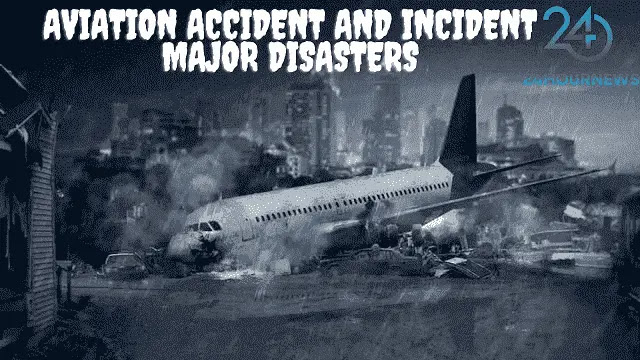Aviation accident and incident Major disasters The first aircraft accident in which 200 or more people were killed occurred on March 3, 1974, when 346 people died in the crash of Turkish Airlines Flight 981. As of April 2020, there have been 33 Aviation accident and incident in which 200 or more people have died. The plane, registration TC-JAV, was a McDonnell Douglas DC-10 that crashed in a forest northeast of Paris.
Aviation accident and incident Major disasters
The London-bound plane crashed shortly after taking off from Orly air port; All 346 people on board died. after investigation It was later determined that the cargo door detached, affect ease in explosive decompression; This caused an error that led to the collapse of the floor directly above it.
The collapsed floor severed the control cables, leaving the pilot without control of the elevators, rudder, and No. 2 engine. The aircraft entered a steep dive and occurrence crashed. It was the deadliest plane crash ever until the Tenerife disaster in 1977. It is currently the deadliest single plane crash with no survivors.
The top ten countries with the highest number of Aviation accident and incident
The top ten countries with the highest number of fatal civil aircraft accidents from 1945 to 2021 are the United States, Russia, Canada, Brazil, Colombia, the United Kingdom, France, Indonesia, Mexico, and India.
It was noted that the United Kingdom had the highest number of Aviation accident and incident in Europe, with a total of 110 Aviation accidents and incidents during this time period, and Indonesia was the highest in Asia with 104 accidents, followed by India with 95 accidents.
The largest loss of life on a single plane Aviation accident and incident
The largest loss of life on a single aircraft is 520 deaths in the 1985 Japan Airlines flight accident, and the largest loss of life on multiple aircraft in a single accident is 583 deaths in the two Boeing 747s that collided in the 1977 Tenerife airport disaster, while The largest overall loss of life in a mass incident is 2,996 deaths in the coordinated terrorist destruction of aircraft and buildings occupied in the September 11, 2001 attacks.
After Aviation accident and incident, flight safety and security are improved
During more than a hundred years of implementation, aviation safety has improved dramatically. In modern times, two major manufacturers still produce heavy passenger aircraft for the civilian market: Boeing in the United States and Airbus in Europe.
These two manufacturers focus heavily on the use of aviation safety equipment, which is now a billion-dollar industry in its own right; Safety is a major selling point for these companies, as they understand that the airline industry's poor safety record is a threat to the companies' survival.
Some of the major safety devices now required in commercial aircraft are:
- Evacuation slides, to help passengers quickly exit an aircraft in the event of an emergency
- Advanced avionics, including computerized automatic recovery and alert systems
- Turbine engines with improved durability and fault recovery mechanisms
- Landing gear that can be lowered even after power and hydraulics are lost
Air travel is measured on the basis of passenger distance, and is the safest form of transportation available: the figures quoted are those shared by the airline industry when citing air safety statistics.
A typical statement, for example, by the BBC: "Land air operation in the UK is among the safest modes of transport anywhere. When compared to all other modes of transport on a fatality-per-mile basis, air transport is It is the safest – six times safer than traveling by car and twice as safe as railroads.”
However, when measuring deaths per person transported, buses are the safest mode of transport. Air travel deaths per person are surpassed only by bicycles and motorcycles. This statistic is used by the insurance industry when calculating insurance rates for air travel.
For every billion kilometers traveled, trains have a fatality rate 12 times higher than that of air travel, and automobiles have a fatality rate 62 times greater than air travel. By contrast, buses are the safest mode of transportation for every billion trips taken. With this measure, air travel is three times more dangerous than car transportation, and about 30 times more dangerous than bus travel.
A 2007 study by Popular Mechanics found that passengers seated in the back of an aircraft are 40% more likely to survive a crash than those seated in the front. The article quotes Boeing, the FAA, and an aircraft safety website, all of which claim that there is no "safer" seat.
The study examined 20 accidents without taking into account safety developments after those Aviation accident and incident. However, the flight data recorder is usually mounted in the aircraft's tail (tail section) where it is most likely to survive a severe crash.
Between 1983 and 2000, the survival rate for people in US airplane crashes was greater than 95 percent.
Global distress and safety system in the field of Aviation accident and incident
In an effort to prevent incidents such as the disappearance of Malaysia Airlines Flight MH370, a new standard has been issued that requires all commercial aircraft to report their location every 15 minutes to air traffic controllers regardless of country of origin. Introduced by the International Civil Aviation Organization in 2016, the regulation contains no initial requirements for the installation of any new aircraft equipment.
The standard is part of a long-term plan, called the Global Aviation Distress and Safety System (GADSS), that will require new aircraft to be fitted with data broadcast systems that are in constant communication with air traffic controllers. GADSS is similar to the Global Maritime Distress and Safety System (GMDSS) used for maritime safety.
Airline Aviation accident and incident reporting system
The Aviation Safety Reporting System (ASRS) collects voluntarily submitted reports of aviation safety incidents/situations from pilots, controllers, and others. ASRS uses the reports to identify system deficiencies, and issues alert messages, and produces two publications, CALLBACK, and ASRS Directline. The information collected is made available to the public and is used by the Federal Aviation Administration, NASA, and other organizations involved in research and aviation safety.

